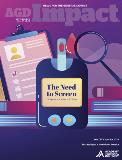 The number of Americans with diabetes is staggering: 30 million Americans are living with: 84.1 million have prediabetes.
The number of Americans with diabetes is staggering: 30 million Americans are living with: 84.1 million have prediabetes.
Studies have shown that diabetics are more susceptible to the development of oral infections and periodontal (gum) disease than those who do not have diabetes. Oral infections tend to be more severe in diabetic patients than non-diabetic patients. And, diabetics who do not have good control over their blood sugar levels tend to have more oral health problems. These infections occur more often after puberty and in aging patients.
This online toolkit is available to help members access resources related to diabetes awareness and diagnosis. It includes a series of videos to educate members on when and how to perform a blood sugar (A1C) test on patients at risk for diabetes or prediabetes.
There is a bidirectional relationship between blood sugar levels and periodontal disease. Diabetics have a higher than average risk of periodontal disease and tooth loss, and people with periodontal disease are at higher risk of developing Type 2 diabetes.
The good news is that if blood sugar is well-controlled through diet and medication, diabetics have the same frequency of periodontal disease as the general public.
AGD President-elect Bruce Cassis, DDS, MAGD, leads the following educational series. Dr. Cassis practices in West Virginia, where he has incorporated blood sugar testing in his practice. West Virginia is greatly impacted by diabetic epidemic: 15% of the population has diabetes, and an additional 36% has prediabetes. Dr. Cassis demonstrates how to use a glucometer during a dental procedure and provides tips on talking to patients and referring them to physicians for treatment.
Screening for Diabetes
Facts about Screening for Diabetes
Dentists should first be aware of the common risk factors for developing prediabetes or Type 2 diabetes. They include being overweight, having a family history of diabetes, being 45 years or older, being physically inactive and having high blood pressure or high cholesterol. Certain ethnic groups also are more likely to develop diabetes.5 Providers should also evaluate for oral symptoms of uncontrolled diabetes, which include a dry mouth or burning sensation in the mouth, delayed wound healing, more frequent and severe infections, thrush, parotid salivary gland enlargement, gingivitis and periodontitis.
Patients with these risk factors or symptoms can be screened to test either their hemoglobin A1C level, which is the patient’s average blood sugar level over the past two to three months, or their blood glucose level, which is the amount of glucose in the patient’s blood at the time of testing.
How to Test Blood Sugar
Blood glucose and A1C levels both can be tested with a finger-prick blood test. Research has found that blood collected from the gingiva at a dental visit can also be used for screening with similar results.
- Wash your patients hands.
- Place a test strip into the meter.
- Prick the side of your patient's fingertip with the lancet to get a drop of blood.
- Hold the edge of the test strip to the drop of blood.
- Wait for the results. The meter will display your current blood sugar levels.
This page is supported by Colgate and in partnership with the American Academy Family Physicians and the American Association of Diabetes Educators.


